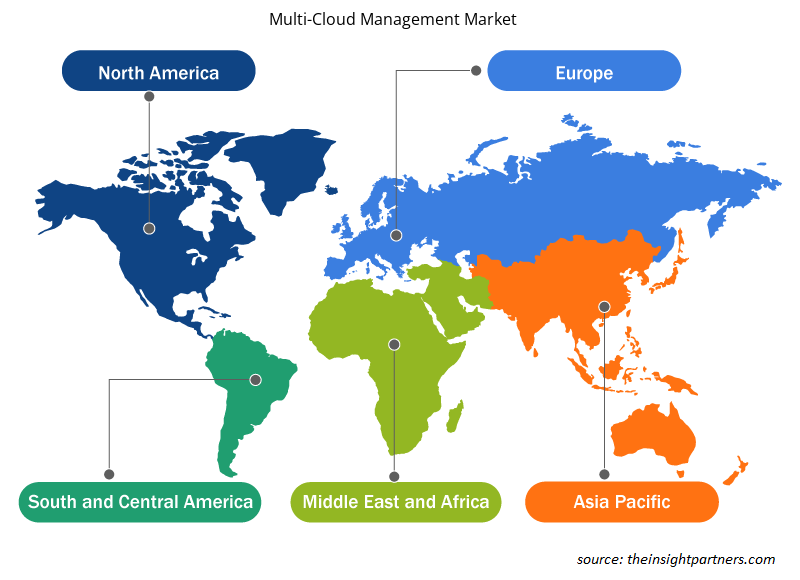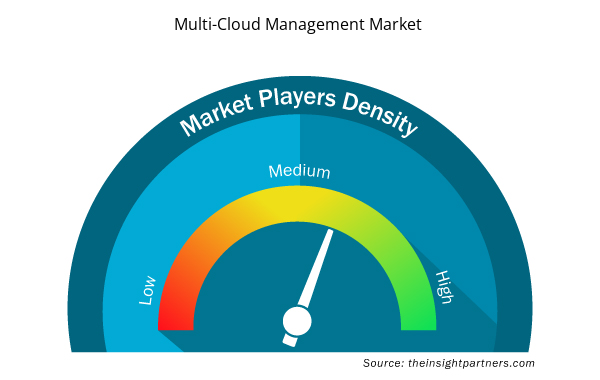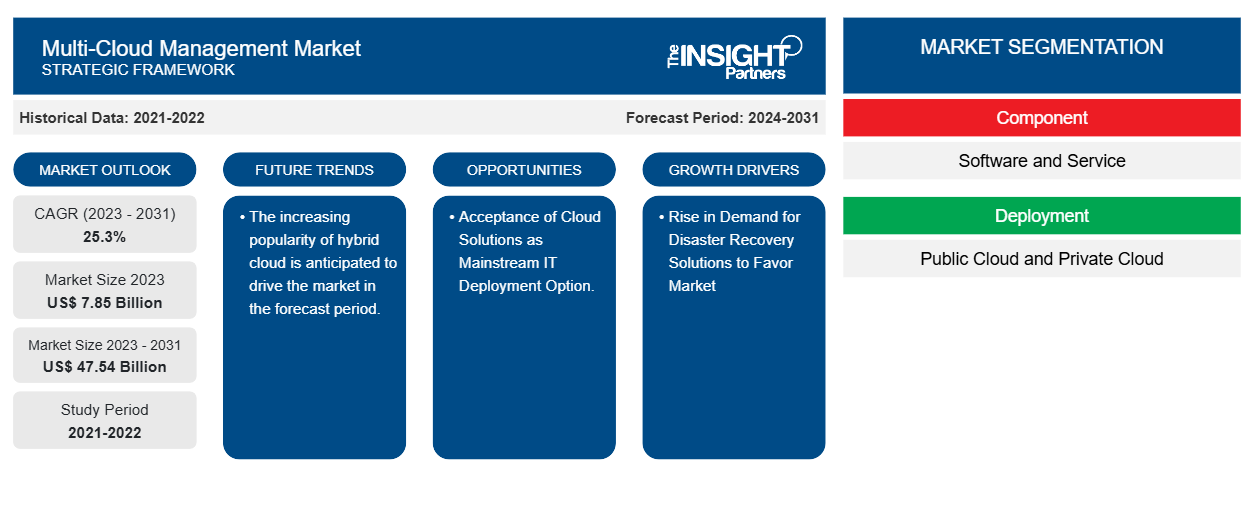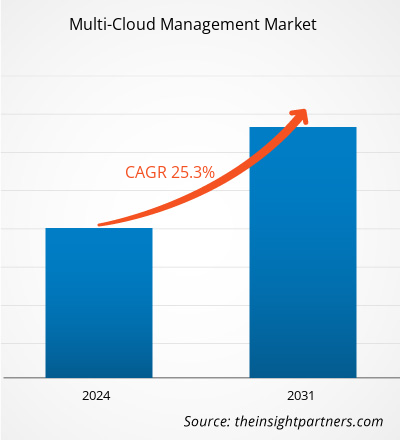マルチクラウド管理市場規模は、2023 年の 78 億 5,000 万米ドルから 2031 年には 475 億 4,000 万米ドルに達すると予測されています。市場は 2023 年から 2031 年にかけて 25.3% の CAGR を記録すると予想されています。ベンダー ロックインを回避する必要性が急増しています。ベンダー ロックインとは、組織が現在のベンダーからビジネスを移行することを選択したものの、予測されるコスト、期間、切り替えの複雑さなどのいくつかの理由により移行できない状況を指します。また、災害復旧ソリューションの需要の増加は、マルチクラウド管理市場の主要なトレンドと推進要因になる可能性があります。
マルチクラウド管理市場分析
マルチクラウド管理市場は、世界中で著しい成長を遂げています。この成長は、ベンダー ロックインを回避する必要性の高まりと、災害復旧ソリューションの需要の増加によるものです。さらに、ハイブリッド クラウドの人気の高まり、データ生成の増加、BYOD (デバイス持ち込み) と CYOD (デバイス選択) の増加が、今後数年間で市場を牽引すると予想されています。
マルチクラウド管理市場の概要
マルチクラウド管理は、企業が複数のパブリック クラウドにわたってアプリケーションとワークロードを保護および監視できるようにする一連のツールと手順と見なされます。マルチクラウド管理ソリューションにより、IT チームは単一のインターフェイスから複数のクラウドを管理でき、Azure や AWS などの複数のクラウド プラットフォームをサポートします。
要件に合わせてレポートをカスタマイズする
このレポートの一部、国レベルの分析、Excelデータパックなど、あらゆるレポートを無料でカスタマイズできます。また、スタートアップや大学向けのお得なオファーや割引もご利用いただけます。
- このレポートの主要な市場動向を入手してください。この無料サンプルには、市場動向から見積もりや予測に至るまでのデータ分析が含まれます。
マルチクラウド管理市場の推進要因と機会
災害復旧ソリューションの需要増加が市場を有利に導く
災害復旧 (DR) は、あらゆるクラウド展開の重要な側面です。World Backup Day の統計によると、毎月 10% のコンピューターがウイルスに攻撃され、30% の人がデータをバックアップしていません。さらに、他の場所にバックアップされていないデータをスタッフが消去するなどの事故が、災害の 29% を占めています。さらに、市場ではさまざまな企業が災害復旧ソリューションの提供に取り組んでいます。たとえば、Persistent Multi-Cloud Disaster Recovery ソリューションにより、企業はアプリケーションのモビリティとデータ保護を制限なく実現し、ビジネス耐性を実現できます。IT 管理者は、ハイブリッドおよびマルチクラウド インフラストラクチャ内のすべてのアプリケーション、オペレーティング システム、コンテナー、データベース、データなどを安全かつ迅速に保護できます。
クラウド ソリューションを主流の IT 展開オプションとして受け入れる。
世界中の大多数の企業が、クラウド サービスを実現可能な IT 展開モデルとして受け入れています。クラウド導入の最も人気の高い理由は、配信プラットフォームとしてのクラウドの柔軟性とデータ セキュリティです。多くの企業が 1 つ以上のクラウド サービスに移行し、他社が競争上の優位性を得るためにクラウドを採用するよう影響を与えています。クラウドは現在、組織の IT 戦略のコンテキスト内で信頼できる展開モデルとして認識されており、満足度は高いままで、現在クラウド サービスを利用している世界中のエンド ユーザーの 3 分の 2 が、今後 1 年間でそのフットプリントを拡大することを期待しています。
マルチクラウド管理市場レポートのセグメンテーション分析
マルチクラウド管理市場分析の導出に貢献した主要なセグメントは、コンポーネント、展開、アプリケーション、および業種です。
- マルチクラウド管理市場は、コンポーネントに基づいてソフトウェアとサービスに分かれています。ソフトウェアセグメントは、予測期間中に大きな市場シェアを占めると予想されます。
- マルチクラウド管理市場は、導入に基づいてパブリッククラウドとプライベートクラウドに分けられます。パブリッククラウドセグメントは、予測期間中に大きな市場シェアを占めると予想されます。
- アプリケーション別に見ると、市場はインフラストラクチャとリソース管理、アイデンティティとポリシー管理、コンプライアンス管理、計測と課金、プロビジョニングとライフサイクル管理に分類されます。インフラストラクチャとリソース管理セグメントは、予測期間中に大きな市場シェアを占めると予想されます。lifecycle management. The infrastructure and resource management segment is anticipated to hold a significant market share in the forecast period.
- 業種別では、市場はITおよび通信、BFSI、政府、小売および消費財、旅行およびホスピタリティ、ヘルスケアおよびライフサイエンス、その他に分類されています。ITおよび通信セグメントは、予測期間中に大きな市場シェアを占めると予想されます。BFSI, government, retail and consumer goods, travel and hospitality, healthcare and life science, and others. The IT and telecom segment is anticipated to hold a significant market share in the forecast period.
マルチクラウド管理の地域別市場シェア分析
マルチクラウド管理市場レポートの地理的範囲は、主に北米、アジア太平洋、ヨーロッパ、中東およびアフリカ、南米および中米の 5 つの地域に分かれています。
マルチクラウド管理市場は北米が独占しています。北米のマルチクラウド管理市場の増加は、データの大幅な増加、IoTとクラウドインフラストラクチャの採用の増加、データセンター建設の急増が主な原因です。クラウドコンピューティングは、北米のすべての組織にわたる大きなトレンドです。クラウドは、米国とカナダの企業にとって急速に新しい標準になりつつあります。さらに、米国とカナダの先進経済における研究開発の重視により、北米のプレーヤーは技術的に高度なソリューションを市場に投入せざるを得なくなっています。さらに、米国には、革新的なソリューションの開発にますます重点を置いているマルチクラウド管理市場のプレーヤーが多数存在します。これらすべての要因が、この地域のマルチクラウド管理市場の成長に貢献しています。
マルチクラウド管理市場の地域別分析
予測期間を通じてマルチクラウド管理市場に影響を与える地域的な傾向と要因は、Insight Partners のアナリストによって徹底的に説明されています。このセクションでは、北米、ヨーロッパ、アジア太平洋、中東およびアフリカ、南米および中米にわたるマルチクラウド管理市場のセグメントと地理についても説明します。

- マルチクラウド管理市場の地域別データを入手
マルチクラウド管理市場レポートの範囲
| レポート属性 | 詳細 |
|---|---|
| 2023年の市場規模 | 78.5億米ドル |
| 2031年までの市場規模 | 475億4千万米ドル |
| 世界のCAGR(2023年~2031年) | 25.3% |
| 履歴データ | 2021-2022 |
| 予測期間 | 2024-2031 |
| 対象セグメント | コンポーネント別
|
| 対象地域と国 | 北米
|
| 市場リーダーと主要企業プロフィール |
|
マルチクラウド管理市場のプレーヤー密度: ビジネスダイナミクスへの影響を理解する
マルチクラウド管理市場は、消費者の嗜好の変化、技術の進歩、製品の利点に対する認識の高まりなどの要因により、エンドユーザーの需要が高まり、急速に成長しています。需要が高まるにつれて、企業は提供内容を拡大し、消費者のニーズを満たすために革新を起こし、新たなトレンドを活用し、市場の成長をさらに促進しています。
市場プレーヤー密度とは、特定の市場または業界内で活動している企業または会社の分布を指します。これは、特定の市場スペースに、その市場規模または総市場価値に対してどれだけの競合相手 (市場プレーヤー) が存在するかを示します。
マルチクラウド管理市場で事業を展開している主要企業は次のとおりです。
- BMCソフトウェア株式会社
- シスコシステムズ株式会社
- フレクセラ
- インターナショナル・ビジネス・マシーンズ・コーポレーション
- マイクロフォーカスインターナショナル
- ゼルト株式会社
免責事項:上記の企業は、特定の順序でランク付けされていません。

- マルチクラウド管理市場のトップキープレーヤーの概要を入手
マルチクラウド管理市場のニュースと最近の動向
マルチクラウド管理市場は、主要な企業出版物、協会データ、データベースなどの一次調査と二次調査後の定性的および定量的データを収集することによって評価されます。マルチクラウド管理市場の動向のいくつかを以下に示します。
- Oracle と Google Cloud は、Oracle Cloud Infrastructure (OCI) と Google Cloud テクノロジーを組み合わせてアプリケーションの移行とモダナイゼーションを加速する選択肢を顧客に提供するパートナーシップを発表しました。(出典: Oracle、企業ウェブサイト、2024 年 6 月)
- Verizon Business は、企業がパブリック、プライベート、ハイブリッドの複数のクラウド環境にわたるアプリケーション コンポーネントとネットワーク アーキテクチャを統合オンライン ポータルで制御できるようにする新しいサービス、Network as a Service (NaaS) クラウド管理を発表しました。(出典: Verizon、企業 Web サイト、2024 年 2 月)
マルチクラウド管理市場レポートの対象範囲と成果物
「マルチクラウド管理市場の規模と予測(2021〜2031年)」レポートでは、以下の分野をカバーする市場の詳細な分析を提供しています。
- 対象範囲に含まれるすべての主要市場セグメントについて、世界、地域、国レベルでのマルチクラウド管理市場の規模と予測。
- マルチクラウド管理市場の動向、および推進要因、制約、主要な機会などの市場動向。
- 詳細な PEST/ポーターの 5 つの力と SWOT 分析。
- 主要な市場動向、世界および地域の枠組み、主要プレーヤー、規制、最近の市場動向を網羅したマルチクラウド管理市場分析。
- 市場集中、ヒートマップ分析、主要プレーヤー、マルチクラウド管理市場の最近の動向を網羅した業界の状況と競争分析。
- 詳細な企業プロフィール。
- 過去2年間の分析、基準年、CAGRによる予測(7年間)
- PEST分析とSWOT分析
- 市場規模価値/数量 - 世界、地域、国
- 業界と競争環境
- Excel データセット



Report Coverage
Revenue forecast, Company Analysis, Industry landscape, Growth factors, and Trends

Segment Covered
This text is related
to segments covered.

Regional Scope
North America, Europe, Asia Pacific, Middle East & Africa, South & Central America

Country Scope
This text is related
to country scope.
よくある質問
The expected CAGR of the multi-cloud management market is 25.3%.
The global multi-cloud management market is expected to reach US$ 47.54 billion by 2031.
The increasing popularity of hybrid cloud is anticipated to drive the market in the forecast period.
The key players holding majority shares in the global multi-cloud management market are BMC Software Inc., Cisco Systems, Inc., Flexera, International Business Machines Corporation, Micro Focus International plc, Zerto Ltd., VMware, Inc., Snow Software, Inc., UnityOneCloud, Dynatrace, Inc.
The surge in the need to avoid vendor lock-in and the rise in demand for disaster recovery solutions are some of the factors driving the multi-cloud management market.
North America is anticipated to dominate the multi-cloud management market in 2023.
Trends and growth analysis reports related to Technology, Media and Telecommunications : READ MORE..
The Insight Partners performs research in 4 major stages: Data Collection & Secondary Research, Primary Research, Data Analysis and Data Triangulation & Final Review.
- Data Collection and Secondary Research:
As a market research and consulting firm operating from a decade, we have published and advised several client across the globe. First step for any study will start with an assessment of currently available data and insights from existing reports. Further, historical and current market information is collected from Investor Presentations, Annual Reports, SEC Filings, etc., and other information related to company’s performance and market positioning are gathered from Paid Databases (Factiva, Hoovers, and Reuters) and various other publications available in public domain.
Several associations trade associates, technical forums, institutes, societies and organization are accessed to gain technical as well as market related insights through their publications such as research papers, blogs and press releases related to the studies are referred to get cues about the market. Further, white papers, journals, magazines, and other news articles published in last 3 years are scrutinized and analyzed to understand the current market trends.
- Primary Research:
The primarily interview analysis comprise of data obtained from industry participants interview and answers to survey questions gathered by in-house primary team.
For primary research, interviews are conducted with industry experts/CEOs/Marketing Managers/VPs/Subject Matter Experts from both demand and supply side to get a 360-degree view of the market. The primary team conducts several interviews based on the complexity of the markets to understand the various market trends and dynamics which makes research more credible and precise.
A typical research interview fulfils the following functions:
- Provides first-hand information on the market size, market trends, growth trends, competitive landscape, and outlook
- Validates and strengthens in-house secondary research findings
- Develops the analysis team’s expertise and market understanding
Primary research involves email interactions and telephone interviews for each market, category, segment, and sub-segment across geographies. The participants who typically take part in such a process include, but are not limited to:
- Industry participants: VPs, business development managers, market intelligence managers and national sales managers
- Outside experts: Valuation experts, research analysts and key opinion leaders specializing in the electronics and semiconductor industry.
Below is the breakup of our primary respondents by company, designation, and region:

Once we receive the confirmation from primary research sources or primary respondents, we finalize the base year market estimation and forecast the data as per the macroeconomic and microeconomic factors assessed during data collection.
- Data Analysis:
Once data is validated through both secondary as well as primary respondents, we finalize the market estimations by hypothesis formulation and factor analysis at regional and country level.
- Macro-Economic Factor Analysis:
We analyse macroeconomic indicators such the gross domestic product (GDP), increase in the demand for goods and services across industries, technological advancement, regional economic growth, governmental policies, the influence of COVID-19, PEST analysis, and other aspects. This analysis aids in setting benchmarks for various nations/regions and approximating market splits. Additionally, the general trend of the aforementioned components aid in determining the market's development possibilities.
- Country Level Data:
Various factors that are especially aligned to the country are taken into account to determine the market size for a certain area and country, including the presence of vendors, such as headquarters and offices, the country's GDP, demand patterns, and industry growth. To comprehend the market dynamics for the nation, a number of growth variables, inhibitors, application areas, and current market trends are researched. The aforementioned elements aid in determining the country's overall market's growth potential.
- Company Profile:
The “Table of Contents” is formulated by listing and analyzing more than 25 - 30 companies operating in the market ecosystem across geographies. However, we profile only 10 companies as a standard practice in our syndicate reports. These 10 companies comprise leading, emerging, and regional players. Nonetheless, our analysis is not restricted to the 10 listed companies, we also analyze other companies present in the market to develop a holistic view and understand the prevailing trends. The “Company Profiles” section in the report covers key facts, business description, products & services, financial information, SWOT analysis, and key developments. The financial information presented is extracted from the annual reports and official documents of the publicly listed companies. Upon collecting the information for the sections of respective companies, we verify them via various primary sources and then compile the data in respective company profiles. The company level information helps us in deriving the base number as well as in forecasting the market size.
- Developing Base Number:
Aggregation of sales statistics (2020-2022) and macro-economic factor, and other secondary and primary research insights are utilized to arrive at base number and related market shares for 2022. The data gaps are identified in this step and relevant market data is analyzed, collected from paid primary interviews or databases. On finalizing the base year market size, forecasts are developed on the basis of macro-economic, industry and market growth factors and company level analysis.
- Data Triangulation and Final Review:
The market findings and base year market size calculations are validated from supply as well as demand side. Demand side validations are based on macro-economic factor analysis and benchmarks for respective regions and countries. In case of supply side validations, revenues of major companies are estimated (in case not available) based on industry benchmark, approximate number of employees, product portfolio, and primary interviews revenues are gathered. Further revenue from target product/service segment is assessed to avoid overshooting of market statistics. In case of heavy deviations between supply and demand side values, all thes steps are repeated to achieve synchronization.
We follow an iterative model, wherein we share our research findings with Subject Matter Experts (SME’s) and Key Opinion Leaders (KOLs) until consensus view of the market is not formulated – this model negates any drastic deviation in the opinions of experts. Only validated and universally acceptable research findings are quoted in our reports.
We have important check points that we use to validate our research findings – which we call – data triangulation, where we validate the information, we generate from secondary sources with primary interviews and then we re-validate with our internal data bases and Subject matter experts. This comprehensive model enables us to deliver high quality, reliable data in shortest possible time.


 このレポートの無料サンプルを入手する
このレポートの無料サンプルを入手する